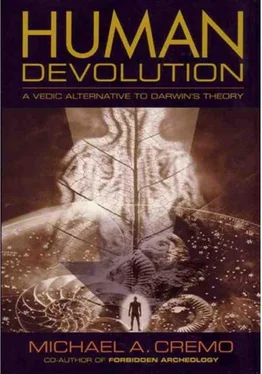Michael Cremo - Human Devolution - A Vedic Alternative To Darwin's Theory
Здесь есть возможность читать онлайн «Michael Cremo - Human Devolution - A Vedic Alternative To Darwin's Theory» весь текст электронной книги совершенно бесплатно (целиком полную версию без сокращений). В некоторых случаях можно слушать аудио, скачать через торрент в формате fb2 и присутствует краткое содержание. Год выпуска: 2003, ISBN: 2003, Издательство: Torchlight Publishing, Жанр: Старинная литература, на английском языке. Описание произведения, (предисловие) а так же отзывы посетителей доступны на портале библиотеки ЛибКат.
- Название:Human Devolution: A Vedic Alternative To Darwin's Theory
- Автор:
- Издательство:Torchlight Publishing
- Жанр:
- Год:2003
- ISBN:9780892133345
- Рейтинг книги:4 / 5. Голосов: 1
-
Избранное:Добавить в избранное
- Отзывы:
-
Ваша оценка:
- 80
- 1
- 2
- 3
- 4
- 5
Human Devolution: A Vedic Alternative To Darwin's Theory: краткое содержание, описание и аннотация
Предлагаем к чтению аннотацию, описание, краткое содержание или предисловие (зависит от того, что написал сам автор книги «Human Devolution: A Vedic Alternative To Darwin's Theory»). Если вы не нашли необходимую информацию о книге — напишите в комментариях, мы постараемся отыскать её.
Human Devolution: A Vedic Alternative To Darwin's Theory — читать онлайн бесплатно полную книгу (весь текст) целиком
Ниже представлен текст книги, разбитый по страницам. Система сохранения места последней прочитанной страницы, позволяет с удобством читать онлайн бесплатно книгу «Human Devolution: A Vedic Alternative To Darwin's Theory», без необходимости каждый раз заново искать на чём Вы остановились. Поставьте закладку, и сможете в любой момент перейти на страницу, на которой закончили чтение.
Интервал:
Закладка:
In his autobiography, Wallace noted that Brewster had written a letter to some of his family members shortly after the séance at Cox’s Hotel. In this letter, Brewster expressed himself somewhat differently than he did in his highly skeptical newspaper letters, written half a year later. After explaining how he and Lord Brougham came to Mr. Cox’s hotel to see Home, Brewster went on to say: “We four sat down at a moderately sized table, the structure of which we were invited to examine. In a short time the table shuddered, and a tremulous motion ran up all our arms; at our bidding these motions ceased and returned. The most unaccountable rappings were produced in various parts of the table, and the table actually rose from the ground when no hand was upon it. A larger table was produced, and exhibited similar movements. . . . A small hand-bell was then laid down with its mouth on the carpet, and after lying for some time it actually rang when nothing could have touched it. The bell was then placed on the other side, still upon the carpet, and it came over to me and placed itself in my hand. It did the same to Lord Brougham. These were the principal experiments; we could give no explanation of them, and could not conjecture how they could be produced by any kind of mechanism. Hands are sometimes seen and felt, the hand often grasps another, and melts away as it were under the grasp” (Wallace 1905, v. 2, pp. 289–290).
Wallace noted some discrepancies between this letter and Sir David’s later accounts: “He told the public that he had satisfied himself that all could have been done by human hands and feet; whereas in his earlier private letter he terms them unaccountable, and says that he could not conjecture how they were done. Neither did he tell his public of the tremulous motion up his arms, while he denied that the bell rang at all, though he had before said that it actually rang, where nothing could have touched it” (Wallace 1905, v. 2, p. 290). Wallace stated that “a similar tendency has prevailed in all the scientific opponents of spiritualism” (Wallace 1905, v. 2, p. 290).
St. George mivart and the miracles at lourdes
A scientist with a more favorable attitude to spiritualistic phenomena was St. George Mivart. Having become acquainted with spiritualism through talks with Wallace and by reading his booklet edition of “The Scientific Aspect of the Supernatural,” Mivart decided to conduct his own investigations. In the winter of 1870, Mivart was in Naples, Italy, where Mrs. Guppy, a medium known to Wallace, resided with her husband. Wallace provided Mivart with a letter of introduction. Mivart attended three séances with Mrs. Guppy. During one séance, he received correct answers to questions he asked mentally. This greatly surprised him. At another séance, which took place in a darkened room, flowers mysteriously appeared. Mivart explained in a letter to Wallace that “the door was locked, the room searched, and all requisite precautions taken. I was not surprised, because of all I had heard from you and others; but the phenomenon was to me convincing. One such fact is as good as a hundred” (Wallace 1905, v. 2, pp. 300–301). In his letter, Mivart listed some conclusions. Among them: “I. I have encountered a power capable of removing sensible objects in a way altogether new to me. II. I have encountered an intelligence other than that of the visible assistants. III. In my séances this intelligence has shown itself capable of reading my thought” (Wallace 1905, v. 2, p. 301).
A few years later, Mivart visited Lourdes, a pilgrimage place in France where miraculous cures occurred, supposedly by the intervention of the Virgin Mary. During his stay at Lourdes, Mivart conducted a study of the cures. Wallace received from Mivart a long letter, dated April 5, 1874, about his findings. Mivart gave several case histories, gathered from French physicians, including Dr. Dozens (Wallace 1905, v. 2, pp. 302–304). Here follow two of them.
Blaisette Soupevue, a woman of fifty, had a severe eye infection lasting several years and affecting her sight. Her eyelids were turned out, lashless, and covered with fleshy growths. Doctors Dozens and Vergez pronounced the case incurable. After bathing her eyes with water from Lourdes, the woman completely recovered her sight, the growths disappeared, and her eyelashes began to grow again.
Justin Bontisharts had a child ten years old, with arms and legs much atrophied because of rickets. The child, who had never been able to walk, was near death. Dr. Dozens, who had treated the case, was present when the mother placed the child in the water at Lourdes. The child remained motionless, so much so that many bystanders thought it dead. Two days after returning home, however, the child, much to the surprise of the parents, began walking normally and continued to do so.
For more documentation of miraculous cures at Lourdes, Wallace recommended to his readers two books by Henri Lasserre, notre Dame de lourdes and les episodes miraculeux de lourdes. “The most remarkable feature of these cures,” wrote Wallace (1905 v. 2, p. 306), “is their rapidity, often amounting to instantaneousness, which broadly marks them off from all ordinary remedial agencies.”
Wallace then described some cases. “One of the most prominent of these, related by M. Lasserre, is that of Frangois Macary, a carpenter of Lavaur. He had varicose veins for thirty years; they were thick as one’s finger, with enormous nodosities and frequent bleedings, producing numerous ulcers, so that it had been for many years impossible for him to walk or stand. Three physicians had declared him to be absolutely incurable. At sixty years of age he heard of the cures at Lourdes, and determined to try the waters. A bottle was sent him. Compresses with this were applied in the evening to his two legs. He slept well all night, and early next morning was quite well; his legs were smooth, and there was hardly a trace of the swollen veins, nodosities, and ulcers. The three doctors who had attended him certify to these facts” (Wallace 1905, v. 2, p. 306).
Most interesting is Wallace’s explanation of the cures. The cures, according to Wallace, were not caused by the water itself but by a “a real spiritual agency,” believed by those cured to be the Virgin Mary (Wallace 1905, v. 2, p. 308). The cures were, however, rare, and it was impossible to predict who would experience a cure. Wallace noted that cures were not limited to patients who were especially religious or otherwise deserving. In this respect, Wallace considered the patients to be similar to spiritualistic mediums, who were not usually paragons of virtue. Because certain patients, like mediums, were somehow sensitive, they were, regardless of other considerations, selected by spiritual entities as the conduits for psychical effects.
In many cases, cured individuals were “induced to try the Lourdes water often by a very unusual combination of circumstances” (Wallace 1905, v. 2, p. 308). To explain this Wallace suggested the following sequence of events in typical cures: (1) spiritual intelligences select particular individuals for their sensitivity to psychic intervention and possession of a normally incurable condition susceptible to paranormal healing; (2) spiritual intelligences begin the cures, unknown to the patients; (3) desiring ultimately to heighten the spiritual awareness of the patients and others, the spiritual intelligences, at critical moments in the cures, implant in the minds of the patients the idea of using Lourdes water or going to Lourdes; (4) the patients act on these implanted suggestions, experience tangible cures, and attribute them to miraculous intervention by the Virgin Mary (Wallace 1905, v. 2, pp. 308–309). According to this scheme, the spiritual intelligences would in these cases act in conformity with the religious and cultural conditioning of the patients. This is an important idea, to which we shall return in coming chapters.
Читать дальшеИнтервал:
Закладка:
Похожие книги на «Human Devolution: A Vedic Alternative To Darwin's Theory»
Представляем Вашему вниманию похожие книги на «Human Devolution: A Vedic Alternative To Darwin's Theory» списком для выбора. Мы отобрали схожую по названию и смыслу литературу в надежде предоставить читателям больше вариантов отыскать новые, интересные, ещё непрочитанные произведения.
Обсуждение, отзывы о книге «Human Devolution: A Vedic Alternative To Darwin's Theory» и просто собственные мнения читателей. Оставьте ваши комментарии, напишите, что Вы думаете о произведении, его смысле или главных героях. Укажите что конкретно понравилось, а что нет, и почему Вы так считаете.












